人教版六年级英语上册第3单元 unit 3 part A let'stalk 教案
- 格式:docx
- 大小:15.82 KB
- 文档页数:4
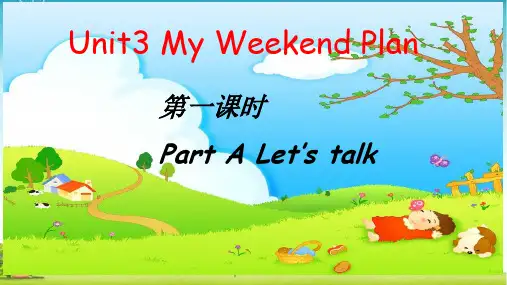
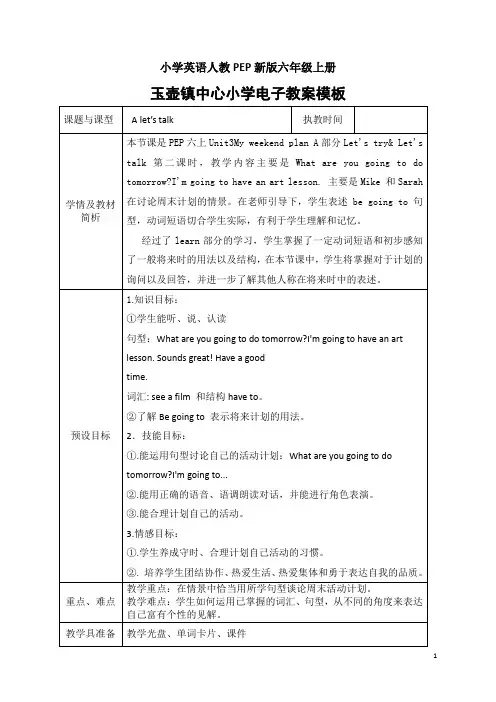
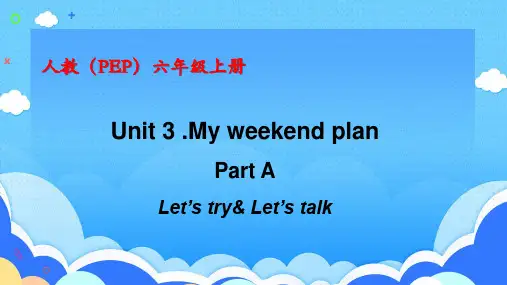
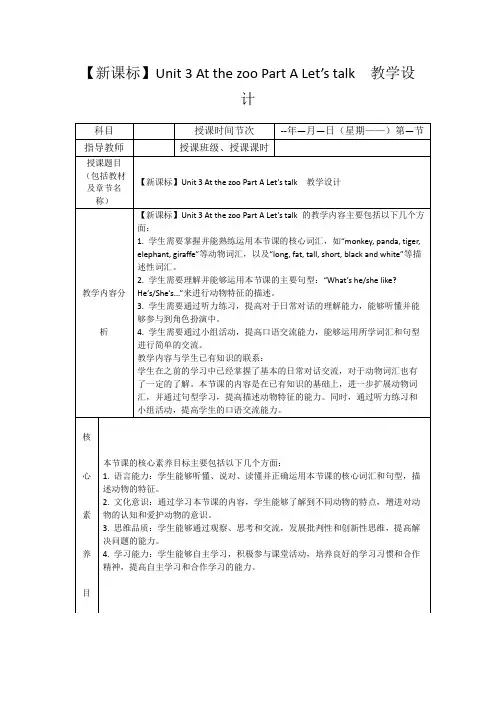


人教pep六年级上册英语《Unit3 My weekend plan A Let’s talk》教学设计一. 教材分析《人教PEP六年级上册英语》第三单元的主题是“我的周末计划”,主要让学生学习并掌握关于周末活动的词汇和表达方式。
本课的内容是《Unit 3 My weekend plan A Let’s talk》,通过一个日常对话,让学生学会询问和描述别人的周末计划,并能够用一般将来时表达自己的计划。
二. 学情分析六年级的学生已经掌握了基本的英语语法和词汇,具备一定的听说读写能力。
他们对于描述自己的日常生活比较感兴趣,而且通过之前的的学习,他们已经掌握了一般现在时和一般过去时的表达方式,这为本节课的一般将来时学习打下基础。
三. 教学目标1.知识目标:学生能够听懂、会说、会读本课的生词和句型,能够用一般将来时描述自己的周末计划。
2.能力目标:学生能够在实际情境中运用所学知识进行交流,提高口语表达能力。
3.情感目标:培养学生热爱生活,积极规划周末生活的态度。
四. 教学重难点1.重点:学生能够听懂、会说、会读本课的生词和句型。
2.难点:学生能够运用一般将来时描述自己的周末计划,正确运用情态动词can。
五. 教学方法采用任务型教学法,情境教学法,合作学习法和激励评价法。
通过设定各种真实的任务情境,让学生在完成任务的过程中,自然的习得语言知识,提高语言运用能力。
同时,鼓励学生合作学习,互帮互助,提高学习效率。
在教学过程中,注重激励评价,激发学生的学习兴趣和自信心。
六. 教学准备1.教师准备:准备好本课的教学PPT,生词卡片,录音机等教学用具。
2.学生准备:提前预习本课的生词和句型,准备进行课堂交流。
七. 教学过程1.导入(5分钟)教师通过提问学生“What do you usually do at the weekend?”,引导学生谈论自己的周末活动,激发学生的学习兴趣。
2.呈现(10分钟)教师通过PPT展示本课的生词和句型,让学生听录音,跟读并模仿。
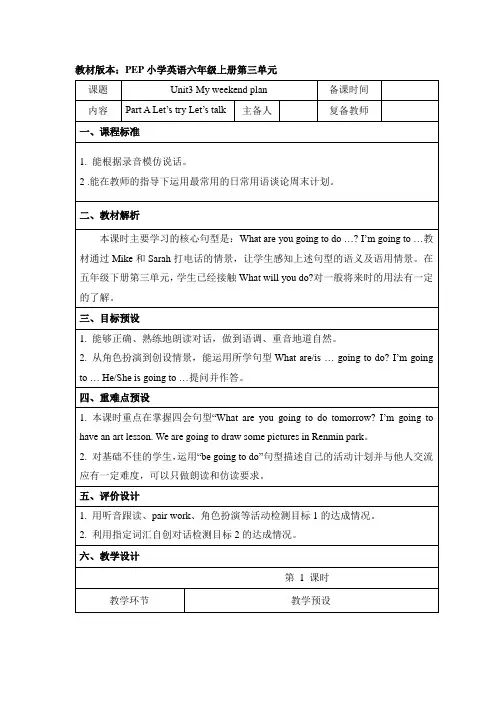

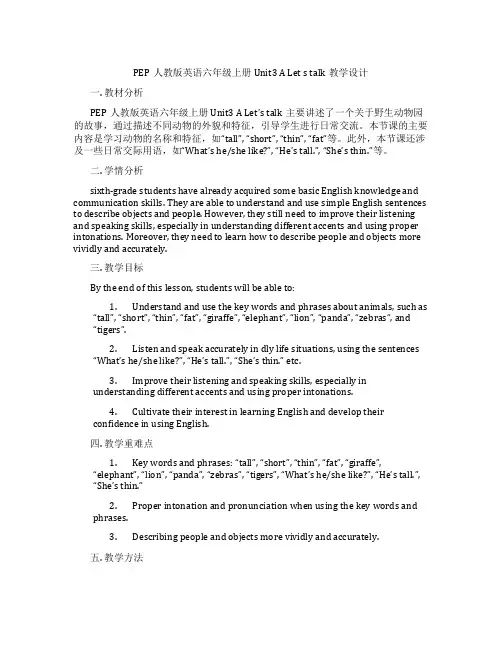
PEP人教版英语六年级上册Unit3 A Let s talk教学设计一. 教材分析PEP人教版英语六年级上册Unit3 A Let’s talk主要讲述了一个关于野生动物园的故事,通过描述不同动物的外貌和特征,引导学生进行日常交流。
本节课的主要内容是学习动物的名称和特征,如“tall”, “short”, “thin”, “fat”等。
此外,本节课还涉及一些日常交际用语,如“What’s he/she like?”, “He’s tall.”, “She’s thin.”等。
二. 学情分析sixth-grade students have already acquired some basic English knowledge and communication skills. They are able to understand and use simple English sentences to describe objects and people. However, they still need to improve their listeningand speaking skills, especially in understanding different accents and using proper intonations. Moreover, they need to learn how to describe people and objects more vividly and accurately.三. 教学目标By the end of this lesson, students will be able to:1.Understand and use the key words and phrases about animals, such as“tall”, “short”, “thin”, “fat”, “giraffe”, “elephant”, “lion”, “panda”, “zebras”, and“tigers”.2.Listen and speak accurately in dly life situations, using the sentences“What’s he/she like?”, “He’s tall.”, “She’s thin.” etc.3.Improve their listening and speaking skills, especially inunderstanding different accents and using proper intonations.4.Cultivate their interest in learning English and develop theirconfidence in using English.四. 教学重难点1.Key words and ph rases: “tall”, “short”, “thin”, “fat”, “giraffe”,“elephant”, “lion”, “panda”, “zebras”, “tigers”, “What’s he/she like?”, “He’s tall.”, “She’s thin.”2.Proper intonation and pronunciation when using the key words andphrases.3.Describing people and objects more vividly and accurately.五. 教学方法1.Audio-visual method: Use pictures, videos, and audio materials to help students better understand the content and improve their listening and speaking skills.2.Task-based language teaching: Create practical tasks for students to apply what they have learned in real-life situations, such as describing animals.3.Cooperative learning: Encourage students to work together in groups to complete tasks and practice their language skills.4.Whole-class teaching: Use questions and answers, discussions, and other interactive methods to engage all students in the classroom.六. 教学准备1.Prepare pictures, videos, and audio materials of different animals.2.Prepare worksheets for students to practice their writing and listening skills.3.Prepare flashcards with pictures and words of the key vocabulary for students to study.七. 教学过程1.Introduction (5 minutes)–Greet students and ask them questions to check their previous knowledge.–Introduce the topic of animals and lead students into the class.2.Presentation (10 minutes)–Show pictures, videos, and audio materials of different animals to help students understand the content.–Introduce the key words and phrases, and teach the sentences “What’s he/she like?”, “He’s tall.”, “She’s thin.”3.Practice (10 minutes)–Divide students into groups and give each group a worksheet to practice their listening and writing skills.–Circulate among the students to help them with their work and answer any questions.4.Consolidation (10 minutes)–Ask students to work in prs to describe a picture of an animal they like.–Encourage students to use the key words and phrases they have learned, and correct their pronunciation and intonation ifnecessary.5.Extension (10 minutes)–Give students a short passage about a zoo, and ask them to read it aloud and answer some questions about it.–Discuss the passage with the students and ask them what they think about the zoo.6.Summary (5 minutes)–Summarize the mn content of the class and ask students if they have any questions.–Remind students to review what they have learned and do their homework.7.Homework (5 minutes)–Give students a worksheet to practice their writing and listening skills.–Remind students to practice their pronunciation andintonation when在本次PEP人教版英语六年级上册Unit3 A Let’s talk的教学设计中,我以教材内容为基础,结合学生的实际情况,制定了明确的教学目标和重难点,并采用了多种教学方法,以期提高学生的英语听力、口语和描述能力。
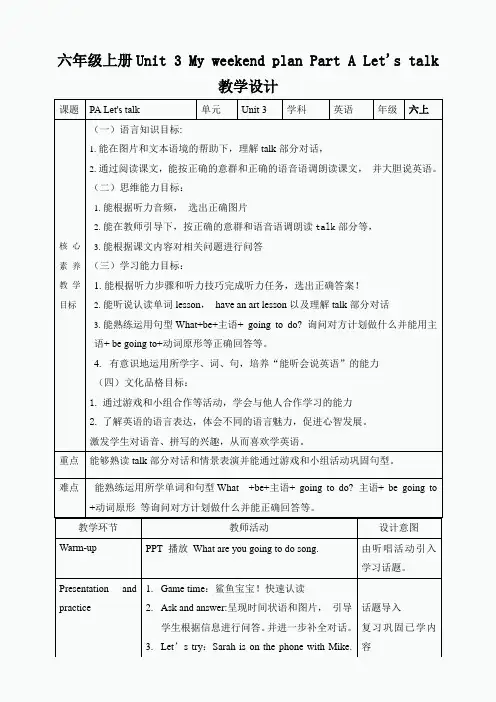
六年级上册Unit 3 My weekend plan Part A Let's talk教学设计课题PA Let's talk单元Unit 3学科英语年级六上核心素养教学目标(一)语言知识目标:1.能在图片和文本语境的帮助下,理解talk部分对话,2.通过阅读课文,能按正确的意群和正确的语音语调朗读课文,并大胆说英语。
(二)思维能力目标:1.能根据听力音频,选出正确图片2.能在教师引导下,按正确的意群和语音语调朗读talk部分等,3.能根据课文内容对相关问题进行问答(三)学习能力目标:1.能根据听力步骤和听力技巧完成听力任务,选出正确答案!2.能听说认读单词lesson,have an art lesson以及理解talk部分对话3.能熟练运用句型What+be+主语+ going to do? 询问对方计划做什么并能用主语+ be going to+动词原形等正确回答等。
4.有意识地运用所学字、词、句,培养“能听会说英语”的能力(四)文化品格目标:1.通过游戏和小组合作等活动,学会与他人合作学习的能力2.了解英语的语言表达,体会不同的语言魅力,促进心智发展。
激发学生对语音、拼写的兴趣,从而喜欢学英语。
重点能够熟读talk部分对话和情景表演并能通过游戏和小组活动巩固句型。
难点能熟练运用所学单词和句型What +be+主语+ going to do? 主语+ be going to +动词原形等询问对方计划做什么并能正确回答等。
教学环节教师活动设计意图Warm-up PPT 播放What are you going to do song. 由听唱活动引入学习话题。
Presentation and practice 1.Game time:鲨鱼宝宝!快速认读2.Ask and answer:呈现时间状语和图片,引导学生根据信息进行问答。
并进一步补全对话。
3.Let’s try:Sarah is on the phone with Mike.话题导入复习巩固已学内容What are they talking about?4.Let’s try:做此类题目,先读题,理解题目的意图,然后带着题目听重点,从而选出正确答案1. Can Mike go swimming today? 2.Why or why not?5.展示听力原文,讲解听力技巧:抓住重点信息: 注意,听力要全面,准确,6.Lead in:They are talking on the phone!大家猜猜What are they going to do tomorrow?然后带着你的猜猜。

Unit3 my weekend plan A部分Let's try &Let's talk第一课时教学设计一、整体设计思路、指导依据说明思路:新课标下,学生就日常话题能描述。
依据:心理学“最近发展区”理论,学生已基本了解动词短语,在教师帮助下,结合本课动词短语(draw some pictures,do myhomework等),结合学生实际,创设情景,学生模拟对话练习,可以基本了解一般将来时be going to用法。
二、教学背景分析:1、教学内容分析:本节课是PEP六上Unit3My weekend plan A部分Let's try& Let's talk 第一课时,教学内容主要是What are you going to do tomorrow?I'm going to have an art lesson.2.学生情况分析:学生掌握了一定动词短语,在老师引导下,会表述be going to 句型,动词短语切合学生实际,有利于学生理解和记忆。
三.教学目标分析1.知识目标:学生能听、说、认读句型:What are you going to dotomorrow?I'm going to have an art lesson. I have to do myhomework now.2.技能目标:①能运用句型讨论自己的活动计划:What are you going to dotomorrow?I'm going to...②能用正确的语音、语调朗读对话,并能进行角色表演。
③能合理计划自己的活动。
3.情感目标:①.学生养成守时、合理计划自己活动的习惯。
②.培养学生日常交流能力,学会与人礼貌交往。
4.学习策略:①.教师引导5.文化意识:a.守时 b. 预约四.教学重点、难点分析:1.教学重点:学生能够听、说、认读句型:What are you going to do tomorrow?I’m going to have an art lesson. I have to do my homework now.2.教学难点:能够运用句型讨论自己的活动计划。
Unit Three My weekend plan
教学目标:
1.能够听、说、读27个单词。
2.学会句型What are you going to do +时间点?并根据所学
单词进行回答。
3.学会句型Where are we going?+答语
课时安排四课时
第二课时
教学目标:
1.能根据所学句型对食物进行询问,并回答回答.
2.能够理解let's talk的大意,会读,并能小组内进行情景对话.
一、板题、示标。
同学们,今天我们来一起学习第3单元Part A let’s talk 部分。
首先,明确本节课的学习目标(投影显示)。
有信心完成学习目标的同学请举手,(好,请放下。
)为了更好地完成学习目标,本节课我们将进行三场比赛,先看第一场比赛。
二、第一次“先学后教”比正确翻译词组意思。
师:请同学们看自学指导
自学指导
要求:
默看P24页,结合单词表,5分钟后比谁能正确翻译出短文意思.
师:时间到,停,随机提问(接下来进行第二场比赛)三、第二次“先学后教”比正确读出词组。
师:请同学们看自学指导
自学指导
要求:
请小组讨论,短文正确读音,5分钟后比哪个小组能最准确读出短文。
师:时间到,停,分组抽测(接下来进行第三场比赛)
个性化设计:
Be going to表示计划或打算的句型。
Eg:I am going to clean the bedroom this afternoon。
三、第三次“先学后教”比正确翻译词组进行情景对话。
师:请同学们看自学指导
自学指导
要求:
1.小组长进行提问
2.老师抽测(5分钟)
师:时间到,停,分组抽测
个性化设计:
have to 不得不,表示不得不做某事;第三人称单数形式
为has to,后接动词原形。
Eg:He has to go there。
他不得不去那里。
I have to eat vegetables。
我不得不吃蔬菜。
课堂总结
What are you going to do tomorrow?
I’m going to have an art lesson。
当堂检测
一、单项选择:
()1.What ______ John going to do tomorrow?
A. am
B. is
C.are
()2.I’m going to ______ Tomorrow at six.
A.meet
B.meeting
C. meets
()3.Robin and I ______ gong to
A.am not
B.isn’t
C.aren’t。